There . . . Go I
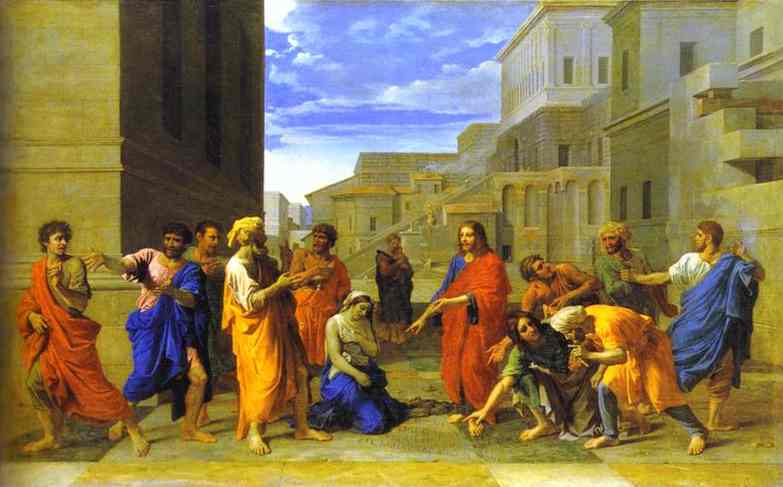
It is not too surprising to animal defenders when persons of a frivolous or cynical turn of mind close their hearts to the message of compassion for our animal cousins. But most of us at some time or other have probably felt shock and dismay on learning that a friend or relative whom we know to be actively, even heroically compassionate toward human beings will not even consider ceasing to eat animals. Perplexity is mixed with our pain; how can this sensitive, large-hearted person suddenly be so small?
It is part of the greater question: why do any people resist the work of the Spirit of Love in this area of their lives? Is the process significantly different for the cynical and for the (otherwise) compassionate? Various reasons for resistance have been suggested, ranging from inertia to addiction. No doubt there are many factors, some personal and some common to major personality types. I would like to offer some insights derived from the area of psychology known as victimology, the study of victimized persons and the often cold reactions of others to their suffering.
The Belief in a Just World
One of the major pioneers in this field is Melvin J. Lerner, whose work, published in The Belief in a Just World, arose in part out of the puzzling attitude of many of the medical students he was teaching in the early 1960s. The course included information about the particular needs of impoverished Appalachian mining families in their state, whose plight was a result of steep wage drop or job disappearance due to automation and other sociological factors. But Lerner was surprised to find his students showing no sympathy at all, only callous assertions that "these people" were lazy and irresponsible, neglected their children, and didn't want to work. No amount of information that Lerner assembled to show the miners' innocence made any impact. The students blocked out all evidence as though they were racial bigots of the worst sort, although in fact they were generally bright, mature young people. (pp. 4-5)
Lerner and his colleagues began a series of experiments designed to explore people's reactions to victimization. Typically, he would arrange for a white-coated "research assistant" to have a group of students watch a scenario in which a person was being given electric shocks, in a supposed test of the effects of negative feedback on learning patterns. But the "victim," like the "research assistant," was merely acting, and no shocks were given. Lerner varied the experiments, so that in some cases the watchers could mark an evaluation sheet in a way that would spare the victim any further shocks; but in other cases, this "rescue" was not an option. Sometimes the victim was depicted as a martyr-like figure enduring it so that the students could get their course credit. (pp. 41-53)
Lerner found that initially there was always strong empathic response to the supposed victim's suffering, with observers jerking as they saw the "victim" jerk; they gasped, some tittered nervously, some looked away as if to evade the sight on the screen, and the like. After a time, these responses died down, and all watched intently. When they evaluated their own initial feelings afterwards, they said they had been very upset, and were furious with the research assistant for perpetrating such an injustice. But with time, most of them swallowed their fury, and finally did not even protest the cruelty of the experiment (41-53).
When instructed to evaluate the victim, those who had been in a position to act to stop any further shocks would usually evaluate her neutrally. But those who were helpless to do anything had a strong tendency to rate her negatively. She was "a fool" to put up with the shocks, she was "weak," she rated low on a scale of attractiveness, and the like. (pp. 41-53) Evidently the students were motivated to alleviate their empathic pain, either consciously by saving the victim from further suffering, or unconsciously by putting her down so that her victimization wasn't such an egregious thing after all.
Such repeated evidence of victim-blame led Lerner to formulate the theory that people convince themselves that they live in a just world--at least to a limited extent. Small children usually believe in such a just world literally: they expect bad behavior to lead always to punishment. However, by adulthood people have become aware that injustices happen and go unpunished. This situation implies a kind of moral chaos where chance rules--an intolerable situation that destroys the motivational basis for carrying on a meaningful life. In order to function normally, people need to believe that taking reasonable precautions, and working in a disciplined manner, will keep them safe and enable them to achieve essential goals. It also encourages decent behavior to others, with the expectation of getting decency in return. To avoid the collapse of meaning, observers tend to sequester victims geographically (injustices happen only to people at a distance, like the Appalachian miners) and/or view them as unattractive or unworthy people, unlike Our Own Kind, who live in a world where decency and justice rule.
Ronnie Janoff-Bulman, in her book Shattered Assumptions which focuses on reactions to victims of catastrophes, points out that observers, in order to carry out their lives effectively, need to maintain their threefold assumption that "the world is benevolent,""the world is meaningful" and "I am a capable, valuable person": therefore, a catastrophe like this won't happen to me. They tend to find victims responsible for their own suffering either because of who they are, or what they have done/left undone. For example, if a victim of rape can be made out to be an immoral person, or if she dressed in a slightly provocative manner, she largely got what she deserved (pp. 6-11). Thus the assumption that the world is benevolent/safe, and that I am in control of my own life, is preserved. In retrospect, another's catastrophe will take on a kind of inevitability which the victim should have foreseen. Victims will sometimes blame themselves in a some such way, because this helps them rebuild the assumption of future control and safety.
By avoiding or even abusing victims, and shutting out any evidence that belies their own complex of assumptions, observers can maintain their basic trust in the world, the confidence to go on with their own lives as before. For victims, it is like getting back into the driver's seat after a bad accident, and rebuilding confidence that one can get safely to one's destination.
People who acknowledge the fact that catastrophes do happen to innocent people (and that thus they themselves may become victims) can maintain belief in an ultimately benevolent world by concepts such as a loving Divine Providence, karma, or a healing afterlife. (This is not to disprove such concepts, which must be evaluated according to meaningfulness and evidence.)
The Victimization of Farmed Animals
In order to maintain the assumption of a just and benevolent world despite the horrors inflicted on farmed animals, it is not necessary to show that the animals have done something to deserve their terrible fate; people can maintain distance from them merely because of who they are. I can continue as a capable person living in a meaningful world without fear of the catastrophe of being crammed into a truck and being driven to a horrible death in a slaughterhouse, because I am not a cow or pig or fowl. However, benefiting from this system potentially belies my assumption that I am a decent and worthy person, who therefore deserves my good fortune of being the eater instead of the eaten. As readers of these pages well know, any such anxieties are ordinarily handled, on a culture-wide level, by simply not thinking about the situation. And the observer's belief in a just world is maintained by standard terminology that puts down farmed animals--they are ugly, fat, stupid, dirty, lazy, lacking in feeling, etc., and thus fall outside of the system. When animal advocates bring to people's attention some of animals' admirable qualities, and point out the injustice of their suffering, another defense is a bromide like "it's a dog-eat-dog world," or "nature (or evolution) is violent, you can't fight it.," conveniently ignoring evidence that the human devouring of animals is overwhelmingly a cultural affair, and is quite unnecessary.
It is not altogether surprising, then, that even some compassionate persons --who may often be emotionally exhausted--may feel they cannot risk disturbing the fragile balance they have already achieved as they try to do their part in rectifying the world's injustice. By their compassion toward their fellow humans, they have already gone far beyond the mainstream who tend to manipulate the facts to maintain their just-world assumptions. The compassionate probably feel their present actions are already the tiniest drop in a Great Lake of unjust suffering--they dare not allow the lake to become the Pacific Ocean.
It is an encouraging thing, however, to remember that the too-frequent complex of oblivious or callous responses to the plight of victims, including animals, in fact arises out of suppressed empathy, an unexamined sense that "There, but for the grace of God, go I." It is an empathy that, partly because of anxiety created by threats to the meaningfulness of one's world and one's self-image as a decent person, is not allowed (so far) to flower into action, but it is still empathy. Human hearts are not stones; we have there the seed of compassion. Whether one sees this empathy as arising from the image of God in human beings, or as the divine Light in our hearts, or simply as decent fellow-feeling, we can appeal to it with hope.
News Notes
Iceland Stops Whale-Hunting for the Present
Due to the low demand for whale meat, Iceland has decided to stop whale-hunting at least until the market demand increases and Japan issues an export license. According to Iceland's fisheries minister, Einar K. Gudfinnsson, "There is no reason to continue commercial whaling if there is no demand for the product."
Iceland’s decision to stop whale-hunting is a clear example of the power the consumer has. As children of God, we are called to be compassionate and merciful; therefore, we should not support those industries that cause unnecessary suffering to God’s animals.
--Contributed by Lorena Mucke
Christian Vegetarian Association
www.christianveg.com
Good News for “Veal” Calves
The American Veal Association (AVA) voted unanimously to convert the industry to group housing by 2017 and therefore phase out veal crates. They give reasons such as: consumers are showing concern, group housing is legislatively imposed in the European Union, and group housing will promote industry stability and growth.
--Contributed by Lorena Mucke
Paws for Kids
Paws for Kids is a foster-animal service that was started up in the northwest of England by a group of women who recognised that there is a gap in the provision of services to women and their families who were escaping from violent homes. While refuges [shelters] could accommodate women and their children, they could not take in any companion animals. Animals had to be either left behind to suffer at the hands of the violent man, given away to someone else, or even put down. Often women remain in a violent relationship rather than have to abandon animals to the batterer or give them away permanently. Paws for Kids offers some peace of mind for such women and children, who know the animals are safe while they await re-housing from a refuge.
The group's work does not end there. To help run the service, they recruit a team of women volunteers who attend a training course that provides a thorough understanding of the issues and difficulties faced by families experiencing domestic violence and its effects on companion animals.
Beside the usual areas of domestic violence awareness, confidentiality, etc., the course includes animal handling and managing animal placements. Although for safety reasons the families are not able to have direct contact with their animals while the latter are being fostered, they are kept up to date on their condition and receive photos of their animals to reassure them. Meanwhile, the Pet Foster Carers are doing a fantastic job of caring for what can sometimes be quite traumatized animals too. One of the workers at Paws for Kids is on call 24 hours a day, 7 days a week, in case of emergencies.
--Marian Hussenbux
Quaker Concern for Animals
Implications of the Vick Dogfighting Case Worry Farm Interests
Profiting from the media emphasis on Michael Vick's cruelty to dogs, animal advocacy groups have called attention to the plight of farmed animals as well. Farm moguls are worried because people are getting informed about the inherent cruelty of factory farming, which might drive many to think again about what lies behind their dinner.
--Contributed by Lorena Mucke
Gems
"The saints are exceedingly loving and gentle to mankind, and . . . to brute beasts. . . . Surely we ought to show [animals] great kindness and gentleness for many reasons, but, above all, because they are of the same origin as ourselves."-- John Chrysostom (347 - 407), Archbishop of Constantinople
--Contributed by Lorena Mucke
O God, enlarge within us the sense of fellowship with all living things, our brethren the animals to whom thou gavest the earth as their home in common with us. We remember with shame that in the past we have exercised the high dominion of man with ruthless cruelty so that the voice of the earth, which should have gone up to thee in song, has been a groan of travail. May we realize that they live not for us alone but for themselves and for thee, and that they love the sweetness of life even as we, and serve thee in their place better than we in ours.--St. Basil of Caesarea
--Contributed by Matthew Halteman
“The moral evils of a flesh diet are not less marked than are the physical ills. Flesh food is injurious to health, and whatever affects the body has a corresponding effect on the mind and the soul. Think of the cruelty to animals meat-eating involves, and its effect on those who inflict and those who behold it. How it destroys the tenderness with which we should regard those creatures of God!” ~ Ellen G.White (1827-1915), co-founder of the Seventh Day Adventists.
--Contributed by Lorena Mucke
Book Review: Ghost Cats
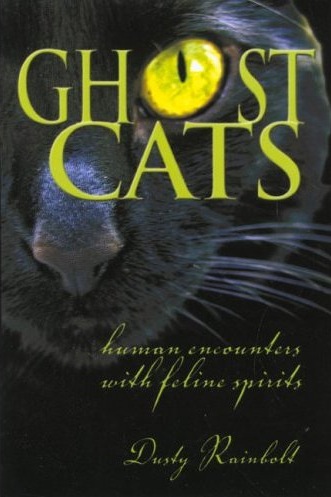 Dusty Rainbolt, Ghost Cats. Guilford, CT: Lyons Press, 2007. xx + 198 pp. $14.95 softcover.
Dusty Rainbolt, Ghost Cats. Guilford, CT: Lyons Press, 2007. xx + 198 pp. $14.95 softcover.
Dusty Rainbolt is an animal behavior scientist, an author, and an editor of Catnip, the well-regarded cat publication of the Tufts University Cummings School of Veterinary Medicine. She loves cats and has always had many strays and adoptees around her home. But she took it for granted that ghosts, feline or human, were nonsense. Until Maynard came back.
Maynard was an active and loving tuxedo cat, despite being hydrocephalic, when Dusty and her husband took him in. For eight months all went well. But one day, while the couple was out of town, Maynard's disease got the better of him. Dusty was understandably full of remorse. Was she right to have left the cat in the care of a friend? If only she could have said goodbye.
Then, about two weeks later, Dusty felt cat-feet walking over her bed, and a heavy cat-body flopping down at Maynard's favorite place across her feet. She could see nothing, but the sensation was unmistakable. This one-time visit was enough to tell Dusty that the animal was happy, and held nothing against her.
Eventually Dusty talked about her experience, expecting disinterest or disbelief. But she was overwhelmed by the number of people who had had, or knew someone who had had, a similar visit. News of her interest snowballed; in time there were more than enough cases for a book.
Ghost Cats' narratives range from the "Demon Cat" occasionally encountered by watchmen in the lower depths of the U.S. capitol in Washington (the only malevolent figure in the book) to a cat who's always playing with an invisible feline friend. A somber but non-threatening black cat appeared and disappeared suddenly and mysteriously to two teenage girls attempting to evoke a spirit by magic; they took it he was trying to warn them against the dangers of such sorcery, and immediately gave up the dark arts. A literary cat is occasionally seen in a Tennessee university library. As one might expect, a number of cat-haunted hotels and mansions can be found, including the home, now a museum, of Margaret Brown ("the Unsinkable Molly Brown") in Denver.
Altogether the book offers some seventy-five tales, some poignant, some amusing, all delightful to cat-lovers. Rainbolt is a good writer who presents these ghost stories as they might have been told by a friend over dinner or before a fire, neither credulously nor critically. The reader can make of them what s/he will; if she has been around cats long enough, she may not want to foreclose too hastily what these magical creatures are capable of.
How does a book like this relate to the concerns of The Peaceable Table? Fundamentally, in that it greatly expands our awareness that beneath the species labels are depths of love, empathy, and commonality that can exist between humans and animals. Once that is fully grasped, the rest follows naturally, from refraining from eating them to the recognition they are companions, not property. Maynard and the rest of the furry spectres seem to be on a mission to our world, and here is their testament.
--Robert Ellwood
Book Review-Essay: The Hero Frees the Serpent: Harry Potter and the Animals
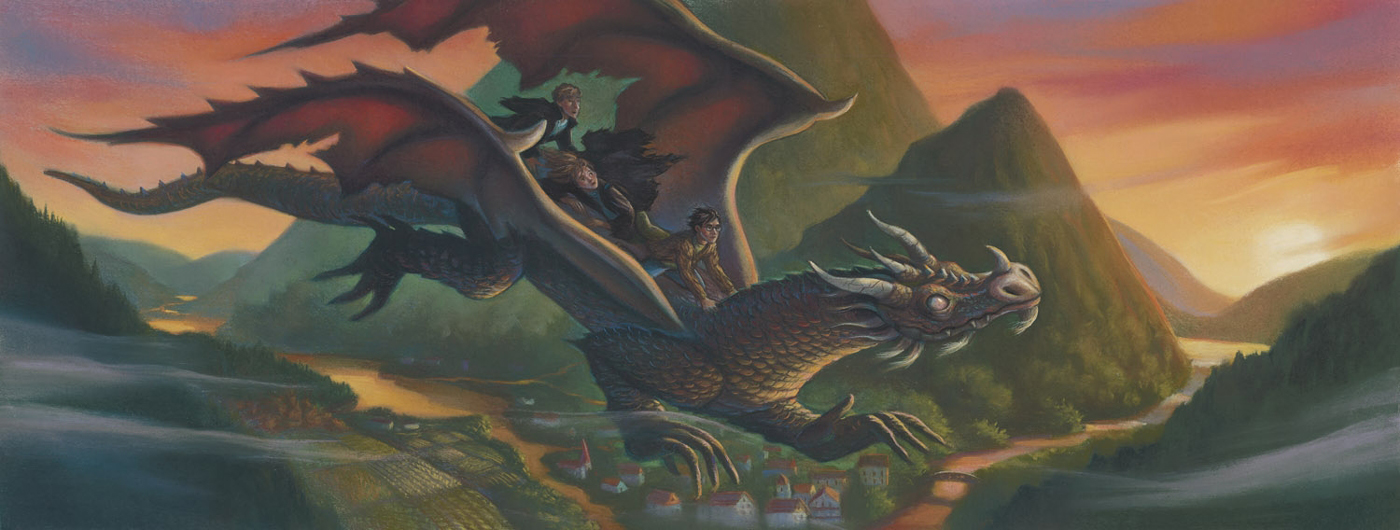
Harry Potter's first major act of magic was to liberate an anaconda (a snake of the boa family) from captivity in a British zoo, where she was being psychologically tormented by rowdy boys banging on the glass of her cage. Without any conscious intention or decision on Harry's part, power seeped out of him and dissolved the glass. What happened to the serpent after she escaped we are not told.
Harry's next act of animal liberation required, by contrast, a lot of conscious planning and great daring, and had plenty of follow-through. This was the case of Buckbeak the Hippogryph. A hippogryph is a fabulous (in every sense of the world) creature: part giant eagle, part horse. Students at Hogwarts are taught how to care properly for hippogryphs, with Rule One being to treat them with respect. Draco Malfoy ("Serpent of Bad Faith") breaks this rule, deliberately insulting Buckbeak. As a result he gets himself slightly injured. With his usual Bad Faith, he pretends the wound is terribly serious, and easily persuades his father, the cruel and powerful Lucius Malfoy, to have Bucky sentenced to death.
Harry and his friend Hermione risk their own lives, liberty, and pursuit of happiness to prevent this judicial murder, and succeed in carrying out a daring rescue (which makes possible the later rescue of an unjustly convicted human being). Harry Potter and the Prisoner of Azkeban should be required reading for all children and adults who love animals. The courage of Hermione and Harry in their act of animal liberation is all too rare, and the Malfoys' attitude that they have the unbounded right to kill animals is, alas, too common.
In Goblet of Fire there are two scenes celebrating animals that deserve mention. In one of them that appears only in the book, a unicorn is petted by ten fourteen-year-old girl students--a scene to melt the discerning heart to tears--while the lovely creature accepts all their caresses with unicornian grace. It just goes to show that, contrary to popular Muggle belief, witches know how to raise their daughters right. The other scene, in the movie but not the book, shows the reprehensible Mr. Filch and his equally unpleasant cat, Mrs. Norris, dancing together--which just goes to show that any two villains who love each other that much can't be all bad.
In Order of the Phoenix we meet relatives of unicorns that J. K. Rowling has discovered, creatures called thestrals, a magical animal that suggests a cross between Pegasus and a pteranodon. Thestrals look like horses from a nightmare, much as unicorns look like horses from a paradisal dream. It has been said (by P. L. Travers) that unicorns can be seen only by those whose eyes are innocent, undimmed by cynicism and doubt. Thestrals, on the other hand, can be seen only by those who have seen someone die: eyes that have been cleansed by tears from the darkest sorrow of the world. Just as Death's angel turns out to be bright, the ghastly appearance of thestrals is misleading; they are gentle and helpful, as Harry learns from the eccentric, caring, and intelligent Luna Lovegood in a scene that appears only in the movie. Luna not only sees more deeply than others, she is not afraid to look weird as she pets and feeds the invisible animal. It is a lesson worth learning.
It must be acknowledged that not all Harry's contacts with animals are positive ones for the animals. For example, the meals at Hogwarts seem particularly heavy with flesh. The food is brought magically to the table, but as it is cooked in the ordinary manner (by enslaved house-elves), it probably has the usual unseen violence behind it, to which Harry and all the other students and faculty are as oblivious as most of the books' readers are with their own dinner entrees. Another example is the death-dealing serpent in Chamber of Secrets that Harry does not liberate but slays in the more usual manner of heroes. But these negative instances are less in evidence than the theme of sympathetic friendship with animal beings.
In the concluding volume of the saga, Deathly Hallows, our hero and his two loyal friends pull off the greatest act of animal liberation ever--at the same time that they pull off the greatest bank robbery ever. To be sure, the object that the trio take out of the bank was there only because it had been stolen by evildoers: "Ladrón que roba a ladrón, mil años tiene de perdon" (A thief who steals from a thief receives a thousand years of forgiveness). To fight the unbeatable foe, to rob the unrobbable bank, one must turn an obstacle into an asset. The goblins who run the bank are utterly confident because they are using as guard nothing less than a captive dragon. They will never do so again after Harry, Hermione, and Ron break out of the satanic subterranean vaults riding the Wyrm out into the light. When the dragon later flies low to drink from a lake, the young magicians jump off, and the magnificent serpent they have liberated flies off to freedom.
Harry has accomplished a new Harrowing of Hell.
Recipes
Black Bean & Brown Rice Burgers
Makes 8 -10 burgers
1 ½ cups black beans, cooked tender
1 cup long grain brown rice, cooked
1 cup extra firm tofu (drained and pressed to remove liquid), crumbled
½ cup whole wheat flour
1 T. extra virgin olive oil
1 T. fresh cilantro
2 tsp. tamari or soy sauce
1 tsp. coriander powder
1 tsp. chili powder
1 clove garlic, coarsely chopped
½ tsp. dried crumbled oregano
½ tsp. dried fennel powder
¼ tsp. sea salt, or to taste
freshly ground pepper, to taste
additional extra virgin olive oil
Preheat oven 400° F.
Place all ingredients in the bowl of food processor except the whole wheat flour. Process ingredients until well mixed; then add the whole wheat flour and process until well incorporated. Remove from processor bowl and place in a stainless steel or glass bowl. Shape into patties/burgers. Line a baking sheet with parchment paper. Place burgers on baking sheet; brush with olive oil. Bake 10 minutes. Remove from oven, turn patties over and bake 10 more minutes. Serve on buns with desired condiments. Ketchup, mustard, Nayonaise, onion, lettuce and tomato are terrific! Or try a more tropical burger and top with Mango –Sweet Pepper Salsa.
--Angela Suarez
Mango- Sweet Red Pepper Salsa
Makes about 1 ½ cups
1 mango, peeled and diced
½ red sweet bell pepper, diced
1 green onion, thinly sliced
2 tsp. freshly squeezed lemon juice
¼ tsp. sea salt, or to taste
freshly ground assorted peppercorns (black, pink, & white), to taste
Place all ingredients in medium sized glass bowl. Toss gently. Serve with tortilla chips or use as a delicious topping for Black Bean & Brown Rice Burgers.
--- Angela Suarez
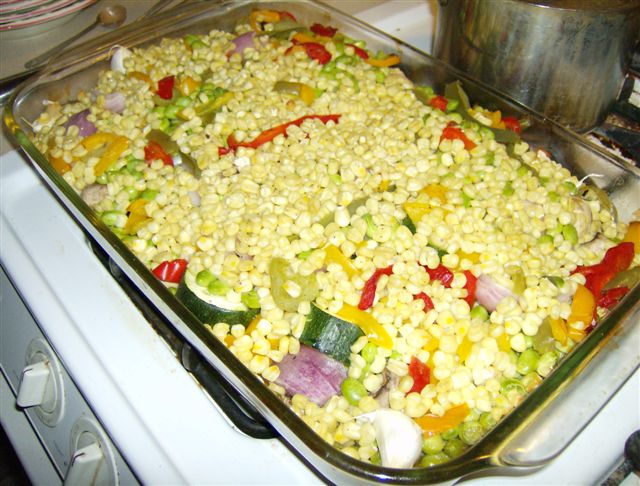 Roasted Edamame and Vegetables
Roasted Edamame and Vegetables
1 lb. frozen shelled edamame
1 lb. frozen sweet corn
½ lb. fresh white or cremini mushrooms, quartered
1 sweet Vidalia onion, cut into wedges (about 8 pieces)
1 red onion, cut into wedges (about 8 pieces)
½ red sweet bell pepper, cut into ¼ - ½ inch strips
½ yellow sweet bell pepper, cut into ¼ - ½ inch strips
¼ green sweet bell pepper, cut into ¼ - ½ inch strips
1 small zucchini, cut into 1 ½ inch pieces
8 cloves garlic, unpeeled
2 T. extra virgin olive oil
½ tsp. sea salt (or to taste)
freshly ground black pepper, to taste
additional extra virgin olive oil, for drizzling
Preheat oven to 400° F. Arrange vegetables in a shallow roasting pan, making sure to add the corn last so that it is on top. Cover with aluminum foil or roasting pan lid. Roast in oven 40 -45 minutes. Remove lid or foil and continue to roast for 10 more minutes. Remove from oven. Drizzle with olive oil and serve immediately.
This dish is a simple and delicious entree when served with fresh bread and green salad; it also makes an elegant side dish. It is easy to assemble and allows time to visit with friends or family as it roasts in the oven. The flavoring from mushroom juices is so delicious no other herbs or spices are necessary. Remember, for the most healthful and delicious dish, to use organic ingredients. To eat the unpeeled garlic, bite the flat end and squeeze into your mouth; or it may be spread on bread and drizzled with additional olive oil.
--- Angela Suarez
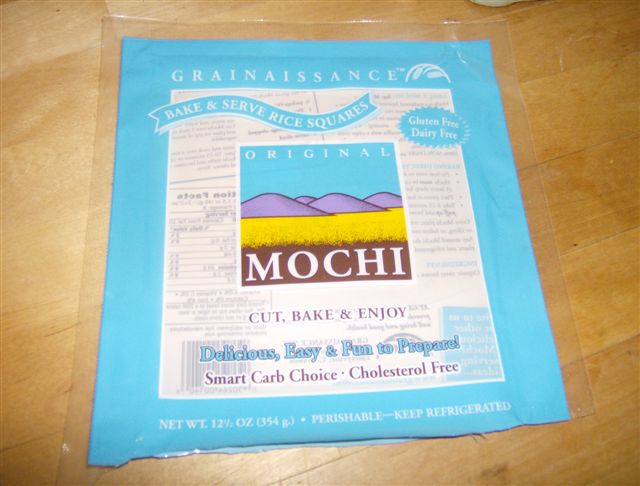
Something Different: Mochi
I recently tried a delicious vegan and gluten-free product called Mochi. It’s available in the refrigerated section of the grocery store. Of course, you may need to visit a grocery store that is off the beaten path or check out a “health food” store. The ingredients are simple in plain/Original Mochi: organic sweet brown rice and filtered water. Please visit the Grainaissance website for more information: www.grainaissance.com/mochi.html
There are many ways to enjoy Mochi. Here is one of my favorites:
Cut the block into squares and bake at 450° F for 8 minutes. While the Mochi is baking, in a medium size bowl toss freshly steamed broccoli (one bunch) with 2 tsp. soy sauce (wheat-free variety), 1 ½ tsp. seasoned rice vinegar, ¼ tsp. (or to taste) hot red pepper flakes, and 2 tsp. finely minced ginger root. Sprinkle with 1 tsp. sesame seeds, and serve with Mochi. Serves 2 – 3.
--Angela Suarez
My Pilgrimage
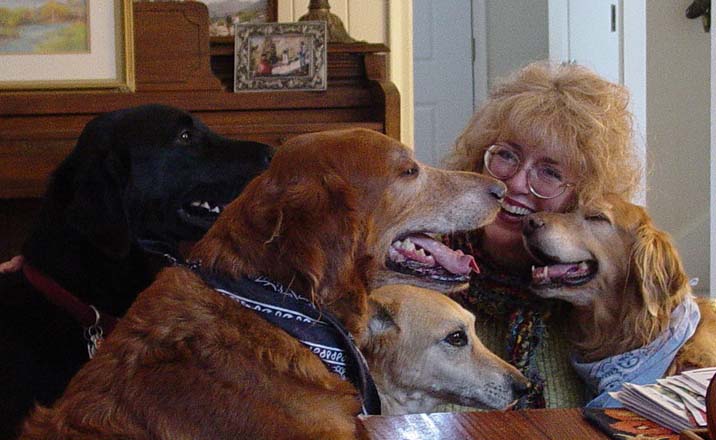
Candi Phillips with Dogs and "Granddogs"
Like most children I adored animals. My love extended to painstaking care for a miniature turtle housed in a plastic oasis complete with pond and palm tree, to playing hide-and-seek with our collie Champ. There were goldfish, and a kitten that proved too fierce to live with small children. There were also rabbit’s foot key fobs that we would take to school and use to absent-mindedly stroke our faces. Too young to make the connection between the vividly dyed “feet” to the wild rabbits that leapt through the field behind our house, I was also an avowed carnivore. There was, of course, the detested liver and onions entree; the meat with its mealy texture and disgusting odor was eaten under great protest. On the other hand, our table would occasionally hold a platter literally covered with an enormous beef tongue. Served with vermicelli and soy sauce, there was nothing better in my mind than thick slices of tongue liberally dotted with salt and sauce. Thanksgiving brought the traditional groaning board feast and my challenge each year was to eat an entire turkey leg.
Childhood soon kaleidoscoped into adolescence. A fashion trend in the late 1950’s was wool coats with raccoon fur collars. Oh, how I wanted one and oh, how delighted I was to join the parade of furs walking into the halls of Hocker Grove junior high school! Waiting at the bus stop when winter winds roared was much easier with the thick ruff of fur around one's cheeks. On a rare shopping trip with my mother she encouraged me to try on a coat with a red fox fur collar, cuffs and hem. The expense and the fact that I didn’t need another coat prevented its purchase, but I remember gazing at my image in the three-way mirror and thinking I looked like a princess.
One summer afternoon my sister and I were walking to the local library. A pickup truck abruptly stopped in front of a home and the driver pitched several objects into the front yard. As he roared away we were horrified to see that those “objects” were tiny kittens. Sobbing uncontrollably we raced into the yard, and, gathering up the miraculously unhurt animals in our arms, we hurried home. We put the little tabbies into a cardboard box and this newly licensed driver made a sad trip to the local pound. We couldn’t keep them and were sure the cute little castoffs would find happy homes.
Graduation, college, marriage, and a whole new family to get to know. Our first trip was to Arkansas to visit my husband’s grandparents, aunts and uncles. Dear and welcoming, they embraced me and made me feel like a “real Phillips.” Meals were, uh, interesting. (Grand)Mom, and Nadine and Bobbie (“Mom’s” daughters) were vegetarians and ate not only vegetables but odd meat-looking loaves from cans. They prepared chicken and other meats for us. Their choice set a wheel turning within me, but the time was not yet right. In time, I met my best-friend-to-be, Jill, at our apartment development. To this day, decades later, I can see her standing in the doorway showing off the rabbit fur coat she bought. An extravagance, but one that was so worth it, given the beauty!
Within weeks I began noticing deer in the daisy-filled field across from our apartments. Soon an article appeared in the newspaper about the upcoming deer-hunting season. I remember the horror, the light bulb finally firing up, as I put one and one together. When a “letter to the editor” protesting the hunt was published I was compelled to locate its author. She was a member of a newly formed animal advocacy group. Within weeks I had been to a meeting, was reading materials from The Humane Society of the United States, and learning about trapping and the fur industry. Jill soon joined the group and put that new fur coat away forever.
Nadine and Bobbie encouraged me to continue my animal advocacy by publishing a newsletter for The Theosophical Society, which I did for thirty years. In that period of time I learned many things about myself: that “in-your-face” protests and hard-sell on animal issues caused animosity and did little if anything to change minds; that I am healthier without consuming animals; that whatever anyone can do COUNTS. Jill, also a writer, became a volunteer for her local wildlife rescue organization. Small birds and mammals were carefully fed, monitored, then released into a life they wouldn’t have had without her loving touch.
I talk to Jill nearly every day – in my heart, for she died ten years ago. Also gone are “Mom,” Nadine, Bobbie, and others who have gently held my hand along the journey. They didn’t force a viewpoint or insist their way was the right way. Their patience, kindness and love brought me here, and I am blessed indeed.
--Candi Ayres Phillips
Letters
Delighted to have found you! We'll have a lot of catching up to do to read all the back issues you have lovingly done, We'd be glad to contribute our story, which goes way back. Funny to talk to younger vegans and realize we have been there since before they were born. Makes us feel old but very pleased (and healthy) that we made this choice. . . . . If you mean that you email everyone that a new issue is online, listing the contents of the new issue, count us in.
Know that it took many years before Quakers united on the human slavery issue. We just have to keep a kind concern going. I guess we're ahead of the curve in our Monthly Meeting because everyone is open to the idea and, since a recent presentation, many are making some dietary changes in that direction. This was the first time we've done this formally. Before that it was just at potlucks, after-meeting snacks and such, that made others notice our diet since we didn't eat some of the selections. So we provided the opening so they could hear the details of our leading. Since our Meetings are concentrating on the issue of global warming, and we have been doing a series of sessions on various aspects, it seemed like a good time to include a session on the impact of our diet on the planet along with other reasons for being vegan.
We know that others will join us in this concern when we use a gentle approach to get our message across. Thanks again for being part of this critical issue.
Love--
--Bob and Sherry Madrone
Apple Seed Meeting, Calif.
Greetings from the Eastern Cape province of South Africa. I am writing to say how much I enjoy your newsletter; it is very encouraging to know that there are like minded Friends and friends.
I am not South African originally but come from Liverpool in U. K. We have lived most of the last 30 years in Africa: Tanzania, Zambia, Malawi, Zimbabwe, and now South Africa. I am completing my Ph.D. (at the age of 57!) ,which concerns the oppression of nonhuman animals. I work as a science teacher in a township school here in Grahamstown, where most of our children are very poor and live in quite a violent environment.
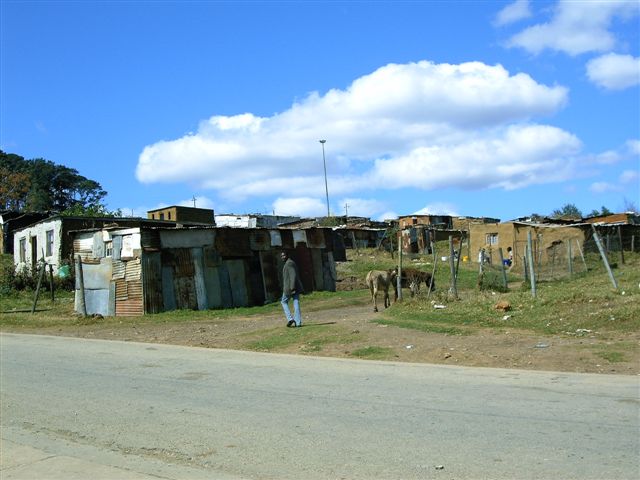 A Scene in Grahamstown Township
A Scene in Grahamstown Township
Anyway, I am pleased to tell you that we do have Friends in Central and Southern Africa who are very concerned about our relationship with our nonhuman sisters and brothers.
Also, a number of the children in school show great concern about animals and some tell me they are vegetarians or want to be, though it is not really part of the culture here.
Thank you for all your efforts and for bringing us insight and inspiration from many sources. Stay well and stay strong.
--Les Mitchell
Pioneer: Anna Sewell, 1820-1878
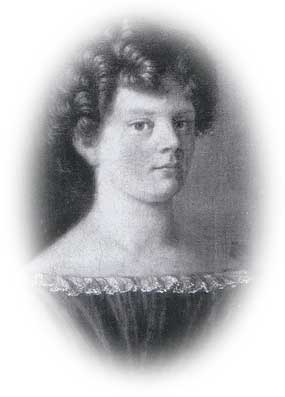 English novelist and activist Anna Sewell was born into a Quaker family in Great Yarmouth, Norfolk, in 1820. Her mother, Mary Wright Sewell, who influenced Anna greatly, was a sensitive, devout, and compassionate woman, a member of an anti-slavery society, and later a successful writer of religious books for children. In early years the family's finances were limited, and Mary taught Anna and her brother Phillip at home.
English novelist and activist Anna Sewell was born into a Quaker family in Great Yarmouth, Norfolk, in 1820. Her mother, Mary Wright Sewell, who influenced Anna greatly, was a sensitive, devout, and compassionate woman, a member of an anti-slavery society, and later a successful writer of religious books for children. In early years the family's finances were limited, and Mary taught Anna and her brother Phillip at home.
The family moved several times, and Anna began to attend a day school at age 12. While walking home in the rain from school one day she fell and injured both her ankles, which never healed properly, limiting her movements thereafter; eventually she became quite crippled. However, she maintained an active cultural life, reading, visiting art galleries, and engaging in painting. Later her search for health took her to several Continental spas, where she met Tennyson and other artists and philosophers.
Anna and her mother left the Society of Friends about 1835, but remained active in evangelical circles in projects to help the wretched urban poor, such as teaching literacy and religion in Sunday and evening schools, and anti-alcohol campaigns aimed to curb wife- and child-abuse and hunger.
When she was 25 her father bought a pony chaise for her to drive about in, and it is probably from this time onward that she developed her love for horses and her sensitive awareness of the abuse so many of them suffered. About age 51 she began work on the book which was to become Black Beauty, intended not for children but for people who worked with horses. At roughly the same time she contracted an unidentified illness that made her more and more a bedridden invalid. However, she intensified her work on the book in 1876, her mother taking her dictation or transcribing what she wrote. She finished it in 1877, and it was published late that same year in a limited edition. She died five months later. I have not found out whether she ever adopted a vegetarian diet.
 Sean Bean as Farmer Grey with Beauty's mother in the 1995 film
Sean Bean as Farmer Grey with Beauty's mother in the 1995 film
The book was promoted by anti-cruelty societies, which led to further editions; thousands of copies were given to school children and horse handlers, and it has never been out of print. More than thirty million copies have been sold. It was the major cause of the abolition of the cruel "bearing rein" which kept horses' heads and necks in a painful and unnatural position. Long after horses ceased to be used in transportation, the book remains popular. This is true especially with children, who tend to identify with animals, and like animals feel relatively helpless in the adult world.
Black Beauty is intended to give a literal "view from below," the story being told in the first person by the eponymous horse, Beauty. This was fairly original, and was vividly and successfully done; the horse expresses his pleasures and pains and his sympathy with other horses, but does not sermonize. The color of the horse and some of the language of the narrative call to mind features of human slavery--a matter of living memory--which increased the book's impact. Beauty is painfully abused at times, but he story has a happy ending, with the horse becoming the beloved companion animal of a kind family who vows never to sell him.
--Gracia Fay Ellwood
From "Anna Sewell" by Prof. Waller Hastings
and other online sources
Poetry: What Was Solomon's Mind?
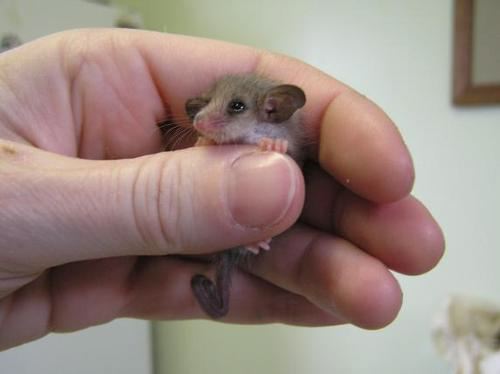
What was Solomon's mind?
If he was wise in truth,
'Twas something hard to find
And delicate: a mouse
Tingling, and small, and smooth,
Hid in a vast haunted house.
By smallness quite beset--
Stillest when most alive--
Shrinking to smaller yet
And livelier, until,
Gladly diminutive,
Still smoother, and more still,
He centers to an Eye,
A clean expectancy,
That, from the narrow black
Safe velvet of his crack,
Quivering, quiet, dumb,
Drinks up the lighted room.
--Geoffrey Scott, 1884-1929)
Credits:
The Peaceable Table is
intended to resume the witness of that excellent vehicle of the Friends
Vegetarian Society of North America, The Friendly
Vegetarian, which appeared quarterly between 1982 and
1995. Following its example, and sometimes borrowing from its
treasures, we publish articles for toe-in-the-water
vegetarians as well as long-term ones, poetry, letters, book
and film reviews, and recipes.
The journal is intended to be
interactive; contributions, including illustrations, are
invited for the next issue. Deadline for the November issue
will be October 29, 2007. Send to graciafay@mac.com
or 10 Krotona Hill, Ojai, CA 93023. We operate primarily
online in order to save trees and labor, but hard copy
is available for interested persons who are not online.
The latter are asked to donate $12 (USD) per year if their means allow. Other
donations to offset the cost of the domain name, server, and
advertising notices are welcome.
Website www.vegetarianfriends.net
Editor: Gracia Fay Ellwood
Book and Film Reviewers: Benjamin Urrutia & Robert Ellwood
Recipe Editor: Angela Suarez
NewsNotes Contributors: Marian Hussenbux & Lorena Mucke
Technical Architect: Richard Scott Lancelot Ellwood


 Dusty Rainbolt, Ghost Cats. Guilford, CT: Lyons Press, 2007. xx + 198 pp. $14.95 softcover.
Dusty Rainbolt, Ghost Cats. Guilford, CT: Lyons Press, 2007. xx + 198 pp. $14.95 softcover.

 English novelist and activist Anna Sewell was born into a Quaker family in Great Yarmouth, Norfolk, in 1820. Her mother, Mary Wright Sewell, who influenced Anna greatly, was a sensitive, devout, and compassionate woman, a member of an anti-slavery society, and later a successful writer of religious books for children. In early years the family's finances were limited, and Mary taught Anna and her brother Phillip at home.
English novelist and activist Anna Sewell was born into a Quaker family in Great Yarmouth, Norfolk, in 1820. Her mother, Mary Wright Sewell, who influenced Anna greatly, was a sensitive, devout, and compassionate woman, a member of an anti-slavery society, and later a successful writer of religious books for children. In early years the family's finances were limited, and Mary taught Anna and her brother Phillip at home.  Sean Bean as Farmer Grey with Beauty's mother in the 1995 film
Sean Bean as Farmer Grey with Beauty's mother in the 1995 film 